Getting to the Summit of Mount Everest. Part 2 - Understanding the 'double S' of Mountaineering
For those just joining us, we are attempting to climb Mount Everest. Well, not in the literal sense of it - and I‘m not sorry to disappoint you :p. We actually want to read our way through to the summit of the highest peak on earth (at exactly 8,848 m above sea level). We started by getting to know as much as we could about the Sagarmatha in the first installment of this mini-series. Today we want to prepare to start climbing by first understanding the Sport and Science (the double S) of mountaineering. In our next and final post of the series, we are going to attempt to climb to the top of the world :D
Let me start today by correcting the title I ascribed to this episode in the first installment. I stated that this episode was going to be about mountaineering and Ice climbing. Actually, Ice climbing is a form of mountaineering (together with rock climbing, hiking and trekking). So placing those two side by side wasn’t exactly ideal.
Having said that, I am going to be sincere with you; mountaineering goes beyond being just a sport. As a lover of football(soccer), one of my favourite quotes of all time is this one by the Great Bill shankly;
Some people believe football is a matter of life and death, I am very disappointed with that attitude. I can assure you it is much, much more important than that.
I like to think of core-mountaineering in that light too. People have literally died trying to climb to the peaks of the world’s greatest mountains. Oh well, I haven’t seen anyone dying from reading. Have you?
So then, let’s get down to business already.
Understanding Mountaineering
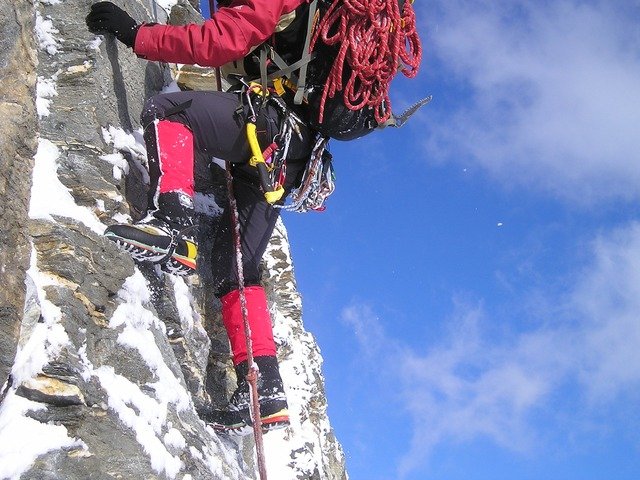 Ascent
(License: CCO Commons]: Pixabay
Ascent
(License: CCO Commons]: Pixabay Mountaineering is the sport of climbing (using hands and legs) or trekking (using only legs) from moderate to high points in mountainous regions. This would include activities ranging from hiking, rock climbing, Ice climbing to trying to get to the peak of one of the high points of the Himalayas using a mix of all. (In our case, we are gunning for the highest).
There are many several reasons for which humans have decided to embark on mountain climbing activities;
Sometimes they climbed for safety, as a view from up high might alert them of an approaching threat. Many people have climbed for adventure; what is above knows what is below. And yes, some people climb because it’s there. Others find deep spiritual meaning in mountains, or have had sacred experiences there. Source
During the ancient times, mountain climbing was forbidden by many cultures like the Ancient Greek kingdom and the Himalayas in Asia due to the belief that mountain tops are inhabited by spirits and gods and are therefore really sacred places. Well, if there’s one thing you are going to count on humans for, it is the fact they wouldn’t mind dining with the spirits as long as it clinches their curiosity.
The claim as to how and where mountaineering began is a really ambiguous topic though it is largely believed to have gained popularity in the 18th century. If you already know me, then you know I’m not really a fan of history. So let’s move ahead…
The two main styles of mountaineering are the Alpine style, which involves fast movement with light equipment, often to heights at about 2,100 to 5,500 m and the Expedition style, which involves a whole lot more ceremonies; more gears, slower pace, more time, and more distinctly – higher elevations, as is with the Mount Everest climb.
Talking about forms of mountaineering; Hiking is the easiest of them; it involves hourly walks on relatively flat to steep terrain such as a coastline or on a mountain. In some cases, hiking is not considered as a mountaineering activity. It is of easy to moderate difficulty and requires minimal equipment and skill when compared to mountaineering activities like ice climbing or rock climbing. Hiking is used by a lot of people as a means of simply exercising and exploring. It is always a nice way to start preparing for an actual mountaineering expedition.
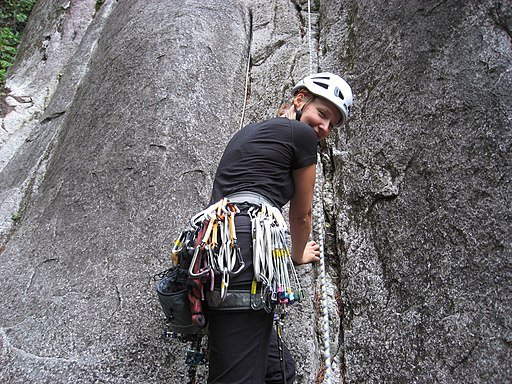 A rock climber (Iwona Erskine-Kellie) with her climbing gears
(License: CC-BY-2.0, Author: Babbage]: Wikicommons
A rock climber (Iwona Erskine-Kellie) with her climbing gears
(License: CC-BY-2.0, Author: Babbage]: Wikicommons In Rock climbing, the aim is to climb your way through to the top of a rock formation using gears (protective and support equipment) as in the case of aid climbing or with the use of only protective equipment as in the case of free climbing; which is more common nowadays. While in Ice climbing, the aim is to climb your way through to the top of an inclined ice formation. It’s of two main types; Alpine Ice climbing and Water Ice climbing.
Alpine Ice climbing is the more popular kind of ice climbing; alpine being the type of ice that comes from precipitation that is frozen and commonly found in mountain environments like the Himalayas. Water Ice climbing involves the climbing of a water frozen off a cliff or any other inclined pathway for water flow. Water Ice is formed as a result of the freezing of a liquid flow of water like in frozen waterfalls.
For someone attempting to climb to the summit of Mount Everest, prior experience of rock climbing and especially Ice climbing are very essential because a mix of both techniques is what is usually needed along the way, because;
Mountaineering is hard work, and often done in cold conditions. To do it requires great physical effort and some practiced skill. Source
Climbing Technique and Gear
The popular misconception people have about mountaineering as it has to do with rock climbing is that one must be have really strong arms and shoulders to be a successful rock climber. This is not entirely true. In fact, one’s arms are just as important as one’s feet when it comes to this activity. The hands - for support and feet - for balance. The feet therefore doing more work because of the extreme importance of balance when climbing. You lose your balance, you lose your life!
Come on, don’t mind me… It’s not that serious. Well maybe it is :p
All the same, it is important to note that;
Three points of contact with the rock are usually kept, either two hands and a foot or two feet and a hand. Source
The eyes (referred to as the fifth element of climbing) are also really important as it makes for careful observation while maneuvering your way through to the top of a cliff, especially to avoid falling weathered rocks and ice blocks and also falling into the traps of Crevasses, potential avalanches and ice falls such as the Khumbu Icefall of Mount Everest South-Col route. Crevasses are deep cracks or fractures that are formed on ice sheets. You do not want to fall into one of them. I kid you not!
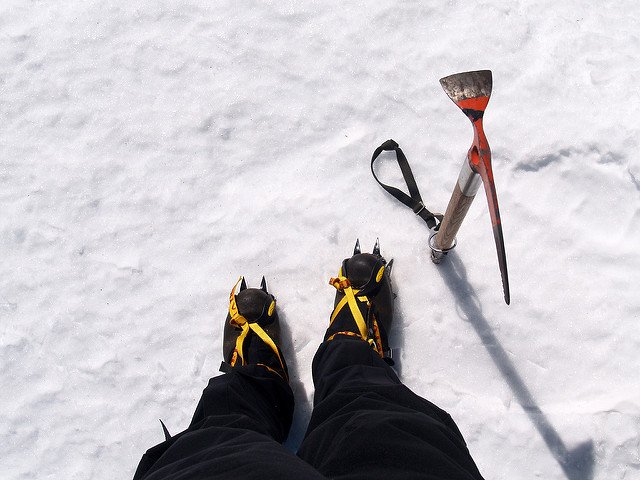 Crampons attached to montaineering boots and a Ice axe
(License: Public Domain]: Flickr
Crampons attached to montaineering boots and a Ice axe
(License: Public Domain]: Flickr Safety and Support gears include items like rope, artificial anchor, and carabiner (a metal link used for clipping ropes to anchors. Crampons are footwear attachments that provide traction on ice and snow due to their spike-shake, hence preventing slipping and improving mobility during climbing.
You use the Ice axe for cutting steps in ice, securing the rope (where necessary), achieving balance (where necessary too), and as a means of arresting a like in the case of a downhill slip, like you see in the movies. Ice screws are threaded tubes with sharp teeth that are screwed into the ice to serve as an anchor for climbers. They usually come in handy especially in the events of crevasse rescue. Helmets are used to protect the head in the event of falls, though some climbers argue that it disrupts their visibility.
Dangers associated with Mountaineering
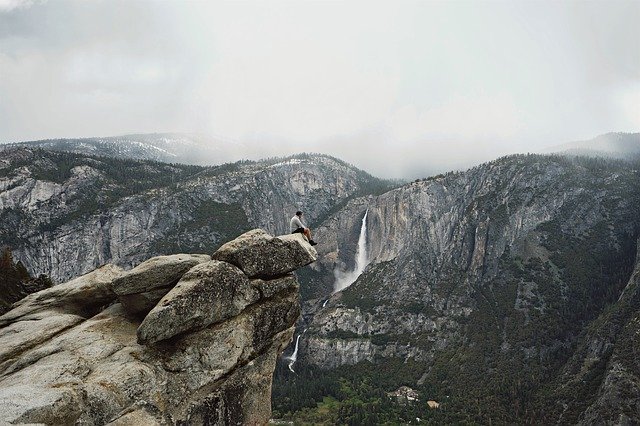 No way I am getting there!
(License: Public Domain]: Pixabay
No way I am getting there!
(License: Public Domain]: Pixabay Once again, Mountaineering is dangeeeerrrrous! It’s no longer news that a lot of people have died from attempting to climb high peak mountains. Mount Everest alone has claimed close to 300 lives over the years. Personally, climbing Mount Everest is something I had always wanted to do until I actually began writing this series. Now I'm beginning to think I’ll just have to pass… But hey – No Guts, No Glory! Right?
Even with all the guts, it’s still important you understand what you are getting into. This article may not give you a comprehensive detail of the whole matter but it sure points in the right direction. Let’s start by categorizing mountaineering Hazards;
Dangers in mountaineering are sometimes divided into two categories: objective hazards that exist without regard to the climber's presence, like rockfall, avalanches and inclement weather, and subjective hazards that relate only to factors introduced by the climber. Equipment failure and falls due to inattention, fatigue or inadequate technique are examples of subjective hazards. Source
Climbers must be wary of falling pieces of weathered rocks and ice blocks which is especially rapid above the snow-line (not to be mistaken with frost-line). You wouldn’t want a rock, kicked out of its home by the process of weathering and about to hit rock bottom due to gravity's influence, knocking you out as you try to make your way through to the very top where it has been relegated from. Trust me, it's gonna hit you so hard.
Another issue is that of climbers falling off a rocky mountain or sliding down ice or snow. This could probably be as a result of wrong handling and/or footing of the climber, or the slippery nature of ice slope. In the case of the latter, crampons are usually attached to the climber’s boots to prevent such calamities.
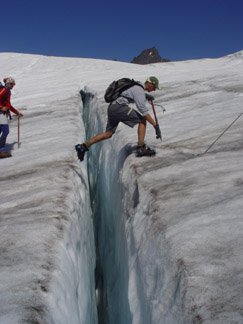 climbers crossing a crevasse
(License: Public Domain]: Wikicommons
climbers crossing a crevasse
(License: Public Domain]: Wikicommons Crevasses are narrow or deep cracks that form a discontinuity along the slope. They are usually formed when a glacier travels over an uneven bed of rocks or ice. A crevasse could be either a narrow crack (slit) or a deep, steep-sided channel (chasm) that takes a person for an unwanted ride to the abyss beneath the mountain – In some cases, never to return. Okay I don’t mean to sound like a writer of thriller or horror movies but this is just plain facts. I mean, look at the picture yourself - imagine one of those guys falling into that.
So crevasses could be either open, which is actually less risky, or hidden, which makes it the more dangerous. As such, it is better to adhere to the following instructions;
Above the snow-line they are frequently hidden by arched-over accumulations of winter snow. The detection of hidden crevasses requires care and experience. After a fresh fall of snow they can only be detected by sounding with the pole of the ice axe, or by looking to right and left where the open extension of a partially hidden crevasse may be obvious. The safeguard against accident is the rope, and no one should ever cross a snow-covered glacier unless roped to one, or even better to two companions. Anyone venturing onto crevasses should be trained in crevasse rescue. Source
When it comes to climbing mount Everest, weather hazards are the more peculiar ones. Just like climbing any elevation above 7,600 m (25,000 ft) in the Himalayas, the death zone of mount Everest exposes climbers to issues such as rapid breathing and pulse rates as oxygen becomes more and more scarce at such high altitudes; a condition known as hypoxia in which blood tissues are deprived of adequate oxygen. This condition, as it progresses, could lead to more fatal, life-threatening situations like High-altitude cerebral edema (HACE) and High-altitude pulmonary edema (HAPE); both of which have been described below and require only about 24 hours to become fatal;
(HACE) occurs when the body responds to the lack of oxygen by increasing blood flow to the brain; the brain begins to swell, and coma and death may occur. (HAPE) is a similar condition in which the body circulates additional blood to the lungs; this blood begins to leak into the air sacs, and death is caused essentially by drowning. Source
They are known as the fatal stages of attitude sickness, the lesser effects being symptoms which includes headache, fatigue, stomach illness, loss of appetite, dizziness, and sleep disturbance. Altitude sickness could be partially prevented with the use of supplemental oxygen – bottled oxygen that can be breathed through a mask – but the best alternative is often to get the affected climber back to lower elevations in the event of such occurring so as to expose them to proper oxygen levels.
End note
Well, that’s just about all there is to know about mountaineering, at least as a part of this series. Of course you’d be needing much more than that if you are actually going to embark on this beautiful (albeit dangerous and scary as some of my readers have already pointed out) adventure. But as far as this mini-series is concerned, we have at this point gotten just about all we need to know before we embark on our ‘climbing Mt. Everest’ experience, which is what we shall be doing in the 3rd and final part of the series :D
To learn more about mountaineering from a Mount Everest perspective, you should read the book Into thin air: A Personal Account of the Mt. Everest Disaster
Do you write STEM (Science, Technology, Engineering, and Mathematics) related posts? Then you should consider joining the #steemSTEM community on discord here. If you happen to be from Nigeria, you should also consider including the #stemng tag in your post. You can visit @stemng for more information.
References
Mountaineering | What Is Mountaineering And What Equipment Do I Need?
Hiking vs Trekking vs Mountaineering: What’s The Difference?
you always seem to amaze me
Your post has been selected as #adsactlyspostoftheday :)
Join us in our Discord channel here to drop your post in our post promotion page, and make sure to use the @adsactly tag in the post itself.
Thank you so much.
Hi @writeit!
Your post was upvoted by utopian.io in cooperation with steemstem - supporting knowledge, innovation and technological advancement on the Steem Blockchain.
Contribute to Open Source with utopian.io
Learn how to contribute on our website and join the new open source economy.
Want to chat? Join the Utopian Community on Discord https://discord.gg/h52nFrV